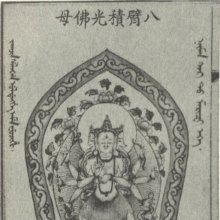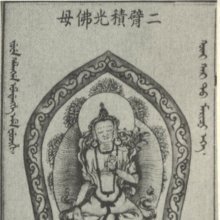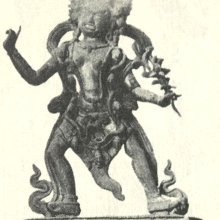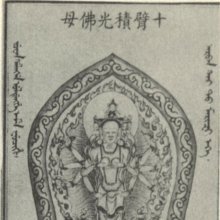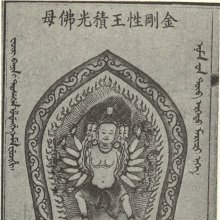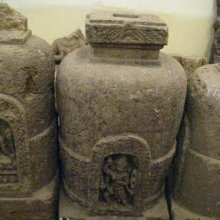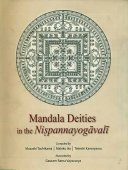Marici, Mārīci, Marīci, Mārīcī, Mārici: 38 definitions
Introduction:
Marici means something in Buddhism, Pali, Hinduism, Sanskrit, Jainism, Prakrit, the history of ancient India, Tamil. If you want to know the exact meaning, history, etymology or English translation of this term then check out the descriptions on this page. Add your comment or reference to a book if you want to contribute to this summary article.
Alternative spellings of this word include Marichi.
Images (photo gallery)
(+31 more images available)
In Hinduism
Shaktism (Shakta philosophy)
Source: Wisdom Library: Śrīmad Devī BhāgavatamMarīchi (मरीछि):—One of the mind-born sons of Brahmā, according to the Devī-bhāgavata-purāṇa (chapter on the Devī-yajña). They were created by the sheer power of mind. Marīchi had a son named Kaśyapa.
Source: Google Books: ManthanabhairavatantramMarīci (मरीचि) refers to “rays”, according to the Śrīmatottara-tantra, an expansion of the Kubjikāmatatantra: the earliest popular and most authoritative Tantra of the Kubjikā cult.—Accordingly, “The rays in the great lotus of sixteen spokes are the rays [i.e., marīci] which are the energies. The supreme goddess is in the End of the Sixteen and she is the supreme seventeenth (energy). The goddess in the End of the Twelve (dvādaśānta) is Mālinī in the form of the Point. She stands in front in the form of the spread tail of a peacock (mayūracandrikā). She always stands before the eyes and (in the form of) many desires she is whirling about (vibhramā). In a moment, time and again, she generates desire in the form of the Point”.

Shakta (शाक्त, śākta) or Shaktism (śāktism) represents a tradition of Hinduism where the Goddess (Devi) is revered and worshipped. Shakta literature includes a range of scriptures, including various Agamas and Tantras, although its roots may be traced back to the Vedas.
Purana and Itihasa (epic history)
Source: archive.org: Puranic Encyclopedia1) Marīci (मरीचि).—A Maharṣi (sage) born from Brahmā’s mind. Birth and Genealogy. The six great sages born from Brahmā’s mind were:—Marīci, Aṅgiras, Atri, Pulastya, Pulaha and Kratu, according to Mahābhārata, Ādi Parva. (See full article at Story of Marīci from the Puranic encyclopaedia by Vettam Mani)
2) Marīci (मरीचि).—A celestial woman. In Mahābhārata, Ādi Parva, Chapter 122, Verse 62 we find that she attended a dance at the celebrations at the time of Arjuna’s birth.
3) Marīci (मरीचि).—An author of Dharmaśāstra. His statements are quoted in Aparārkā, Smṛticandrikā, Mitākṣarā and other works.
Source: archive.org: Shiva Purana - English Translation1) Marīci (मरीचि) refers to “pepper”, which is used in the worship of Śiva, according to the Śivapurāṇa 2.1.14:—“a cow (go) along with necessary adjuncts shall be given in charity and a bull shall also be given. Worship with pepper (marīci) is also conducive to the destruction of enemies. The Śivaliṅga shall be decorated with the leaves of Āḍhakī flowers and worshipped. This worship is conducive to different kinds of happiness and benefits”.
2) Marīci (मरीचि) was created as a Sādhaka (aspirant) by Brahmā out of his eyes (netra), according to the Śivapurāṇa 2.1.16:—“[...] I [viz., Brahmā] created many other things as well, but O sage, I was not satisfied. Then O sage, I meditated on Śiva and his consort Ambā and created aspirants (sādhakas). I created Marīci from my eyes (netra), [...] O foremost among sages, creating thus, thanks to the favour of Mahādeva, these excellent Sādhakas (e.g., Marīci) I became contented. Then, O dear one, Dharma, born out of my conception assumed the form of Manu at my bidding and was engaged in activity by the aspirants”.
Source: Cologne Digital Sanskrit Dictionaries: The Purana Index1a) Marīci (मरीचि).—A mind-born son of Brahmā born with Nārada at the beginning of creation;1 married Kalā a daughter of Kardama;2 father of Kaśyapa;3 came with Brahmā to see Kapila born to Kardama;4 was present in Dakṣa's yajña;5 directed the aśvamedha of Indra;6 came to see the Trivikrama avatār of the Lord;7 did not comprehend Hari's māya.8 The chief sage of Vena's reign responsible for punishing him. A sage in Dāruvana;9 one of the seven sages of Svāyambhuva epoch: instructed by Brahmā on the eighteen purāṇas; praised Śiva, out to destroy Tripuram;10 had a daughter Surūpā, whom Angiras got married.11
- 1) Bhāgavata-purāṇa I. 6. 31; III. 12. 22; IX. 1. 10; Brahmāṇḍa-purāṇa II. 32. 96; III. 1. 21, 43-4; Matsya-purāṇa 3. 6; 4. 26; 195. 9.
- 2) Bhāgavata-purāṇa III. 24. 22; IV. 1. 13.
- 3) Ib. III. 14. 7; 20. 10.
- 4) Ib. III. 24. 9.
- 5) Ib. IV. 7. 43; 29. 43.
- 6) Ib. VI. 13. 21.
- 7) Ib. VIII. 21. 1.
- 8) Ib. IX. 4. 58.
- 9) Brahmāṇḍa-purāṇa II. 21. 115; 27. 104; 36. 133; III. 10. 52; Matsya-purāṇa 145. 90; 154. 352; 171. 27.
- 10) Ib. 9. 4; 53. 12; 102. 19; 127. 24; 133. 67.
- 11) Ib. 196. 1; 245. 86; 250. 4.
1b) A son of Samrāṭ and Utkalā. Father of Bindumatī.*
- * Bhāgavata-purāṇa V. 15. 15.
1c) His wife was Ūrṇā; had six sons in the first antara; then Gods laughed at Brahmā seeking connection with his daughter; these were born of Hiraṇyakaśipu as Asuras, but were taken away by Yogamāyā; then they were born of Devakī and killed by Kaṃsa.*
- * Bhāgavata-purāṇa X. 85. 47-49.
1d) Created from the eyes; one of the Nine Brāhmaṇas alluded to in the purāṇas.*
- * Brahmāṇḍa-purāṇa I. 5; II. 9. 18 and 22; 11. 10; 13. 54.
1e) A sage of the Svāyambhuva epoch;1 son-inlaw of Dakṣa;2 married Sambhūtī;3 advised Dhruva to pray to Viṣṇu.4
- 1) Vāyu-purāṇa 3. 2; 31. 16; 62. 113; 65. 44.
- 2) Ib. 30. 48.
- 3) Brahmāṇḍa-purāṇa II. 9. 55; Vāyu-purāṇa 28. 8; Viṣṇu-purāṇa I. 10. 6; 11. 43.
- 4) Ib. I. 12. 6.
1f) A son of Brahmā married Dharmavratā, the daughter of Dharma whom he cursed for dereliction of duty, to become a stone; got one hundred sons through her; in turn cursed by her for the unjust curse.*
- * Vāyu-purāṇa 107. 7, 26; 112. 36.
1g) A mind-born son of Brahmā; married Sannatī.*
- * Viṣṇu-purāṇa I. 7. 5, 7, 37.
2) Mārīci (मारीचि).—A son of Danu; father of many sons numbering 6000, Paulomas and Kālakeyas, all residents of Hiraṇyapura and could not be killed even by the Devas, because of a special boon from Brahmā; Arjuna slew them;1 his wives, Pulomā and Kālakā, the daughters of Vaiśvānara.2
3a) Mārīcī (मारीची).—The wife of Parjanya.*
- * Brahmāṇḍa-purāṇa II. 11. 19; Vāyu-purāṇa 28. 16.
3b) An Apsarasa.*
- * Brahmāṇḍa-purāṇa III. 7. 6; Vāyu-purāṇa 69. 5.
Marīci (मरीचि) is mentioned as one of the seven mind-born sons of Brahmā, also known as the seven prajāpatis, or the seven brahmās, according to the first chapter of the Brahma-purāṇa (on the origin of Devas and Asuras). Accordingly, “Desirous of evolving creation befitting these, he created Prajāpatis (Lords of subjects) viz. Marīci, Atri, Aṅgiras, Pulastya, Pulaha, Kratu and Vasiṣṭha. Thus the lord of great refulgence created seven mental sons. In the Purāṇas these are known as the seven Brahmās”.
The Brahmapurāṇa (mentioning Atri) is one the eighteen mahāpurāṇas originally composed of over 10,000 verses. The first three books of the extant edition contains a diverse amount of topics such as creation theory, cosmology, mythology, philosophy and genealogy. The fourth and last part represents pilgrimage’s travel guide (māhātmya) and narrates the legends surrounding numerous holy spots (tīrtha) around the Godāvarī region in India.
Source: JatLand: List of Mahabharata people and placesMarīci (मरीचि) refers to the name of a Lady mentioned in the Mahābhārata (cf. I.59.10, I.65, I.60.4). Note: The Mahābhārata (mentioning Marīci) is a Sanskrit epic poem consisting of 100,000 ślokas (metrical verses) and is over 2000 years old.
Source: Shodhganga: The saurapurana - a critical studyMarīci (मरीचि) was created by Brahmā and married Sambhūti: one of the daughters of Dakṣa and Prasūti: one of the two daughters of Manu-svāyaṃbhuva and Śatarūpā, according to the Vaṃśa (‘genealogical description’) of the 10th century Saurapurāṇa: one of the various Upapurāṇas depicting Śaivism.—Accordingly, Ākūti was married to Ruci and Prasūti to Dakṣa. Dakṣa produced in Prasūti twenty-four daughters. [...] [ Sambhūti was given to Marīci.]. [...] From Marīci and Sambhūti, a son named Paurṇamāsa and four daughters Śraddhā etc. were born.

The Purana (पुराण, purāṇas) refers to Sanskrit literature preserving ancient India’s vast cultural history, including historical legends, religious ceremonies, various arts and sciences. The eighteen mahapuranas total over 400,000 shlokas (metrical couplets) and date to at least several centuries BCE.
Vaishnavism (Vaishava dharma)
Source: Pure Bhakti: Bhagavad-gita (4th edition)Marīci (मरीचि) refers to “controlling deity of the fifty kinds of winds in the universe”. (cf. Glossary page from Śrīmad-Bhagavad-Gītā).

Vaishnava (वैष्णव, vaiṣṇava) or vaishnavism (vaiṣṇavism) represents a tradition of Hinduism worshipping Vishnu as the supreme Lord. Similar to the Shaktism and Shaivism traditions, Vaishnavism also developed as an individual movement, famous for its exposition of the dashavatara (‘ten avatars of Vishnu’).
Jyotisha (astronomy and astrology)
Source: Wisdom Library: Brihat Samhita by VarahamihiraMarīci (मरीचि) refers to one of the Seven Ṛṣis (saptarṣi), according to the Bṛhatsaṃhitā (chapter 13), an encyclopedic Sanskrit work written by Varāhamihira mainly focusing on the science of ancient Indian astronomy astronomy (Jyotiṣa).—Accordingly, “During the reign of Yudhisthira, 2526 years before the commencement of Vikrama Śaka, the Seven Ṛṣis (saptarṣi) were at the constellation of Maghā (Regulus). The Ṛṣis take a period of 100 years to go over each of the 27 asterisms. They rise in the north-east and are accompanied by the chaste Arundhatī—the consort of Vasiṣṭha. The eastern-most of the group is Bhagavān Marīci; the next to him is Vasiṣṭha; the next is Aṅgiras and the next two are—Atri and Pulastya. The next in order are the Ṛṣis—Pulaha and Kratu. The chaste Arundhatī closely attends her husband the sage Vasiṣṭha”.

Jyotisha (ज्योतिष, jyotiṣa or jyotish) refers to ‘astronomy’ or “Vedic astrology” and represents the fifth of the six Vedangas (additional sciences to be studied along with the Vedas). Jyotisha concerns itself with the study and prediction of the movements of celestial bodies, in order to calculate the auspicious time for rituals and ceremonies.
Yoga (school of philosophy)
Source: Brill: Śaivism and the Tantric Traditions (yoga)Marīci (मरीचि) refers to one of the seven Sages, according to the 17th-century Haṭhayogasaṃhitā: a compilation on Haṭhayoga that borrows extensively from the Haṭhapradīpikā. The opening verses (1.2–3) acknowledge the seven sages, namely Mārkaṇḍeya, Bharadvāja, Marīci, Jaimini, Parāśara, Bhṛgu and Viśvāmitra, for spreading Haṭhayoga in the world. [...] The Haṭhayogasaṃhitā appears to have been the basis of the Gheraṇḍasaṃhitā (eighteenth century), [...]

Yoga is originally considered a branch of Hindu philosophy (astika), but both ancient and modern Yoga combine the physical, mental and spiritual. Yoga teaches various physical techniques also known as āsanas (postures), used for various purposes (eg., meditation, contemplation, relaxation).
Ayurveda (science of life)
Agriculture (Krishi) and Vrikshayurveda (study of Plant life)
Source: Shodhganga: Drumavichitrikarnam—Plant mutagenesis in ancient IndiaMarīci (मरीचि) refers to the “rays (of the sun)” (used for drying ingredients), according to the Vṛkṣāyurveda by Sūrapāla (1000 CE): an encyclopedic work dealing with the study of trees and the principles of ancient Indian agriculture.—Accordingly: “A healthy seed of a properly ripened Mangifera indica should be soaked in the blood of a tortoise and a hare and then should be dried in the direct heat of the sun (arka-marīci-saṃcaya). After a month it should be planted in a pit, previously prepared as per the method described before. Thereafter it should be showered with the milk of a she-goat. Then it blossoms into a tree with thousands of branches and produces lovely flowers and fruits round the year. This is no wonder”.

Āyurveda (आयुर्वेद, ayurveda) is a branch of Indian science dealing with medicine, herbalism, taxology, anatomy, surgery, alchemy and related topics. Traditional practice of Āyurveda in ancient India dates back to at least the first millenium BC. Literature is commonly written in Sanskrit using various poetic metres.
General definition (in Hinduism)
Source: Wisdom Library: HinduismMarīci (मरीचि) took birth from the mind of Brahmā. From the semen of Marīci, Kaśyapa appeared from the womb of one of the daughters of Dakṣa. (Bhāgavata-pūraṇa 9.1.10)
Source: WikiPedia: HinduismMarichi is the son of Brahma, the cosmic creator, and also one of the Saptarshi (Seven Great Sages Rishi), in the First Manvantara, with others being Atri, Angiras, Pulaha, Kratu, Pulastya, and Vashishtha.
Before the creation started, Lord Brahma needed a few people who can be held responsible for the creation of the remaining Universe. Therefore he created 10 Prajapatis (Ruler of the people) from his Manas (Mind) and 9 from his body. Marichi is one of the manasaputras of Lord brahma. The 10 Prajapatis are as follows:
- Marichi
- Atri
- Angirasa
- Pulaha
- Pulasthya
- Krathu
- Vasishta
- Prachethasa
- Bhrigu
- Narada
Marichi is then married to Kala and gave birth to Kashyap (Kashyap is also sometimes acknowledged as a Prajapati, who has inherited the right of creation from his father).
etymology: Rishi Marichi or Mareechi or Marishi (ṛṣi Marīci, ऋषि मरीचि) (meaning a ray of light)
Source: Sri Kamakoti Mandali: HinduismEight samhitās are attributed to marīci:
- jaya saṃhitā,
- ānanda saṃhitā,
- saṃjnāna saṃhitā,
- vīra saṃhitā,
- vijaya saṃhitā,
- vijita saṃhitā,
- vimala saṃhitā,
- jnāna saṃhitā.
The list of saṃhitās attributed to marīci is provided differently in ānanda saṃhitā -
- jaya saṃhitā,
- ānanda saṃhitā,
- saṃjnāna saṃhitā,
- vīra saṃhitā,
- vijaya saṃhitā,
- vijita saṃhitā,
- vimala saṃhitā,
- kalpa saṃhitā.
In Buddhism
Mahayana (major branch of Buddhism)
Source: Wisdom Library: Maha Prajnaparamita SastraMarīci (मरीचि, “mirage”) refers to one of the ten comparisons (upamāna) according to the 2nd century Mahāprajñāpāramitāśāstra chapter 11. These upamānas represent a quality of the Bodhisattvas, accompanying the Buddha at Rājagṛha on the Gṛdhrakūṭaparvata. They accepted that dharmas are like a mirage (marīci). When the light of the sun (sūryāloka) and the wind (vāyu) stir up the dust (rajas), there is a mirage (marīci); in the desert (kāntāra), it appears as if there were gazelles (ghoṭakamṛga) and, on seeing them, not knowing, we assume the presence of water (vāri). It is the same for the characteristics of male and female (strīpuruṣa): when the sun of the fetters (saṃyojana) and the afflictions (kleśa) has heated up the dust of the formations (saṃskāra) and the wind of bad thoughts (mithyā-manasikāra) swirls in the desert of transmigration (saṃsāra), the person without wisdom asserts the characteristics of male and female (strīpuruṣa). This is a mirage.
Source: academia.edu: A Study and Translation of the GaganagañjaparipṛcchāMarīci (मरीचि) refers to “mirage”, according to the Gaganagañjaparipṛcchā: the eighth chapter of the Mahāsaṃnipāta (a collection of Mahāyāna Buddhist Sūtras).—Accordingly, “Then, the Lord went on to speak these verses: ‘[...] (63) Strive for awakening (bodhi) freed from false view (darśana), and for essential nature (svabhāva) which is like an illusion (māya) and mirage (marīci). Strive to attain non-thought (acitta), even though the thought does not exist in reality, and to teach unchanging dharmas.. [...]’”.

Mahayana (महायान, mahāyāna) is a major branch of Buddhism focusing on the path of a Bodhisattva (spiritual aspirants/ enlightened beings). Extant literature is vast and primarely composed in the Sanskrit language. There are many sūtras of which some of the earliest are the various Prajñāpāramitā sūtras.
Tibetan Buddhism (Vajrayana or tantric Buddhism)
Source: archive.org: The Indian Buddhist IconographyMārīcī (मारीची) refers to one of the emanations of Vairocana, as commonly depicted in Buddhist iconography of.—Mārīcī is invoked by the Lamas of Tibet about the time of sun-rise, which shows her connection with the sun. She too, like the Hindu Sun-god, has a chariot. Her chariot is drawn by seven pigs, while that of the sun is drawn by seven horses. Again, the charioteer of the sun is Aruṇa, who has no legs, but that of Mārīcī is either a goddess with no legs, or Rāhu—only the head without a body.
Various forms of Mārīcī are mentioned in the texts dealing with Buddhist iconography:—Aśokakāntā (two arms, one face), Āryamārīcī, Mārīcīpicuvā or Aṣṭabhujapīta-Mārīcī (three faces, eight arms), Ubhayavarāhānana (three faces, twelve arms), Daśabhujasita-Mārīcī (five faces, ten arms), Vajradhātvīśvarī-Mārīcī (six faces, twelve arms).

Tibetan Buddhism includes schools such as Nyingma, Kadampa, Kagyu and Gelug. Their primary canon of literature is divided in two broad categories: The Kangyur, which consists of Buddha’s words, and the Tengyur, which includes commentaries from various sources. Esotericism and tantra techniques (vajrayāna) are collected indepently.
General definition (in Buddhism)
Source: Wisdom Library: Dharma-samgrahaMārīcī (मारीची, “moonlight”) refers to one of the “five protectors” (pañcarakṣā) as defined in the Dharma-saṃgraha (section 5). The Dharma-samgraha (Dharmasangraha) is an extensive glossary of Buddhist technical terms in Sanskrit (e.g., pañcarakṣā and Mārīcī). The work is attributed to Nagarguna who lived around the 2nd century A.D.
Source: Cambridge Digital Library: Pañcarakṣā, SaptavāraMārīcī (मारीची) refers to the sixth of “seven days” (saptavāra) classified as a dhāraṇī according to a 17th-century Sanskrit manuscript from Nepal .—This collection associates each dhāraṇī with a specific day of the week, a tradition going back to at least the sixteenth century in Nepal.
In Jainism
General definition (in Jainism)
Source: archive.org: Een Kritische Studie Van Svayambhūdeva’s PaümacariuMārīci (मारीचि) participated in the war between Rāma and Rāvaṇa, on the side of the latter, as mentioned in Svayambhūdeva’s Paumacariu (Padmacarita, Paumacariya or Rāmāyaṇapurāṇa) chapter 57ff. Svayambhū or Svayambhūdeva (8th or 9th century) was a Jain householder who probably lived in Karnataka. His work recounts the popular Rāma story as known from the older work Rāmāyaṇa (written by Vālmīki). Various chapters [mentioning Mārīci] are dedicated to the humongous battle whose armies (known as akṣauhiṇīs) consisted of millions of soldiers, horses and elephants, etc.
Source: archive.org: Trisastisalakapurusacaritra1) Mārīcī (मारीची) is the name of an Apsaras, instructed by Śakra to help in the preparations of Ṛṣabha’s wedding-preparations, according to chapter 1.2 [ādīśvara-caritra] of Hemacandra’s 11th century Triṣaṣṭiśalākāpuruṣacaritra: an ancient Sanskrit epic poem narrating the history and legends of sixty-three illustrious persons in Jainism.
Accordingly, “[...] Then having ascertained the Lord’s purpose, Purandara at once summoned gods for the tasks of the wedding-preparations.—‘[...] What are you thinking, Mārīcī? What are you looking at, Sumukhī? Why are you not on this side, Gāndharvī? [...]’. From the bustling of the Apsarases instructing each other in this way, and frequently calling names, a mighty tumult arose”.
2) Marīci (मरीचि) is the name of a son of Bharata, as mentioned in chapter 1.6 of the Triṣaṣṭiśalākāpuruṣacaritra (“lives of the 63 illustrious persons”): a Sanskrit epic poem narrating the history and legends of sixty-three important persons in Jainism. Accordingly, “[...] now, a disciple of the Master, Marīci, a son of Bharata, who knew the eleven aṅgas like his own name, endowed with the qualities of an ascetic, delicate by nature, wandered with the Master like a young elephant with the lord of the herd”.
Marīci incarnates as Tripṛṣṭha (the first Vāsudeva), Priyamitra and finally Mahāvīra (the twenty-fourth Tīrthaṅkara):—“[...] Marīci will attain enlightenment gradually from contact with the fire of pure meditation, like a cloth pure from fire, like pure gold. In this same Bharatakṣetra in the city Potana he will be the first Dāśārha (Vāsudeva), Tripṛṣṭha by name. In course of time, in the East Videhas in the city Mūkā, he will become a Cakrin, Priyamitra, the son of Dhanañjaya and Dhāriṇī. After he has wandered in existence for a long time, he will become the twenty-fourth Tīrthakṛt, Mahāvīra, in Bharatakṣetra”.

Jainism is an Indian religion of Dharma whose doctrine revolves around harmlessness (ahimsa) towards every living being. The two major branches (Digambara and Svetambara) of Jainism stimulate self-control (or, shramana, ‘self-reliance’) and spiritual development through a path of peace for the soul to progess to the ultimate goal.
India history and geography
Source: Cologne Digital Sanskrit Dictionaries: Indian Epigraphical GlossaryMarīci.—a minute unit of measurement. Note: marīci is defined in the “Indian epigraphical glossary” as it can be found on ancient inscriptions commonly written in Sanskrit, Prakrit or Dravidian languages.

The history of India traces the identification of countries, villages, towns and other regions of India, as well as mythology, zoology, royal dynasties, rulers, tribes, local festivities and traditions and regional languages. Ancient India enjoyed religious freedom and encourages the path of Dharma, a concept common to Buddhism, Hinduism, and Jainism.
Languages of India and abroad
Pali-English dictionary
Source: BuddhaSasana: Concise Pali-English Dictionarymarīci : (f.) a ray of light; mirage.
Source: Sutta: The Pali Text Society's Pali-English DictionaryMarīci, (f.) (Vedic marīci; cp. Gr. marmaiρw to shimmer, glitter, maίra dog star, a)maruζsw sparkle; Lat. merus clear, pure; perhaps also mariyādā to be taken here) 1. a ray of light VvA. 166.—2. a mirage J. VI, 209; Vism. 496; VbhA. 34, 85; often combined with māyā (q. v.), e.g. Nd2 680 AII; J. II, 330.

Pali is the language of the Tipiṭaka, which is the sacred canon of Theravāda Buddhism and contains much of the Buddha’s speech. Closeley related to Sanskrit, both languages are used interchangeably between religions.
Sanskrit dictionary
Source: DDSA: The practical Sanskrit-English dictionaryMarīci (मरीचि).—(Rarely marīcī also) m. f. [mṛ-īci Uṇādi-sūtra 4.7]
1) A ray of light; न चन्द्रमरीचयः (na candramarīcayaḥ) V.3.1; सवितुर्मरीचिभिः (saviturmarīcibhiḥ) Ṛtusaṃhāra 1.16; R.9.13;13.4.
2) A particle of light.
3) Light.
4) Mirage.
5) A spark of fire; मरीच्य इव निष्पेतु- रग्नेर्धूमाकुलार्चिषः (marīcya iva niṣpetu- ragnerdhūmākulārciṣaḥ) Rām.1.56.18.
-ciḥ 1 Name of a Prajāpati, one of the ten patriarchs created by the first Manu, or one of the ten mindborn sons of Brahman; he was father of Kaśyapa.
2) Name of a lawgiver.
3) Name of Kṛṣṇa.
4) A miser.
Derivable forms: marīciḥ (मरीचिः).
Source: Cologne Digital Sanskrit Dictionaries: Edgerton Buddhist Hybrid Sanskrit DictionaryMārīci (मारीचि).—name of a yakṣa: Mahā-Māyūrī 83.
--- OR ---
Mārīcī (मारीची).—(1) name of a rakṣā, q.v.: Dharmasaṃgraha 5; surely to be identified with the personification of a charm Śiks 142.5, 9; and probably Sādhanamālā 215.8 etc.; compare (Mahā)māyūrī, which sometimes seems to replace this; (2) name of an ogress: Mahā-Māyūrī 243.12.
Source: Cologne Digital Sanskrit Dictionaries: Shabda-Sagara Sanskrit-English DictionaryMarīci (मरीचि).—m.
(-ciḥ) 1. A saint, the son of Brahma, and one of the Prajapatis, and Brahmadikas, or first created beings, and sovereigns of the world. 2. A niggard, a miser. mf.
(-ciḥ) A ray of light. E. mṛ to perish, (darkness,) Unadi aff. īci .
Source: Cologne Digital Sanskrit Dictionaries: Benfey Sanskrit-English DictionaryMarīci (मरीचि).— (also ºcī, f., [Rāmāyaṇa] 1, 56, 18). I. m. and f. A ray of light, [Vikramorvaśī, (ed. Bollensen.)] [distich] 47. Ii. m. 1. One of the Prajāpatis, [Mānavadharmaśāstra] 1, 58; first of the Pitṛs, 3, 194. 2. A proper name, [Daśakumāracarita] in
Marīci (मरीचि).—[feminine] mote in the air, beam of light (also marīcī); [masculine] [Name] of a Prajapati, the father of Kacyapa.
--- OR ---
Mārīci (मारीचि).—[masculine] patron. from marīci.
Source: Cologne Digital Sanskrit Dictionaries: Aufrecht Catalogus Catalogorum1) Marīci (मरीचि) as mentioned in Aufrecht’s Catalogus Catalogorum:—a pupil of Śaṅkarācārya. Oxf. 248^a.
2) Marīci (मरीचि):—astronomer. Mentioned in Nāradī Saṃhitā. W. p. 257.
3) Marīci (मरीचि):—Siddhāntaśiromaṇivyākhyā by Munīśvara.
4) Marīci (मरीचि):—a C. to the Ramalacintāmaṇi.
Source: Cologne Digital Sanskrit Dictionaries: Monier-Williams Sanskrit-English Dictionary1) Marīci (मरीचि):—mf. (m. only in [Taittirīya-āraṇyaka]; [probably] connected with marut q.v.) a particle of light, shining mote or speck in the air, [Ṛg-veda; Atharva-veda]
2) ray of light (of the sun or moon), [Ṛg-veda] etc. etc.
3) (also cī; f. with somasya = moonlight, [Harivaṃśa])
4) a mirage (= marīcikā), [Kathāsaritsāgara] (cf. marīci-toya)
5) m. Name of a Prajā-pati or ‘lord of created beings’ (variously regarded as a son of Svayam-bhū, as a son of Brahmā, as a son of Manu Hairaṇyagarbha, as one of the 7 sages and father of Kaśyapa, or [according to] to [Manu-smṛti i, 35] as the first of the ten Prajā-patis [q.v.] engendered by Manu Svāyambhuva), [Manu-smṛti; Mahābhārata] etc.
6) of the star η in the great Bear, [Varāha-mihira’s Bṛhat-saṃhitā]
7) of Kṛṣṇa (as a Marut), [Bhagavad-gītā x, 21]
8) of a Daitya, [Harivaṃśa]
9) of a Maharṣi, [Daśakumāra-carita]
10) of the father of Paurṇamāsa, [Purāṇa]
11) of a king (son of Samrāj and father of Bindu-mat), [ib.]
12) of a son of Tīrthaṃ-kara Ṛṣabha, [Horace H. Wilson]
13) of a son of Śaṃkarācārya and various other teachers and authors, [Catalogue(s)]
14) a miser, niggard (= kṛpaṇa), [cf. Lexicographers, esp. such as amarasiṃha, halāyudha, hemacandra, etc.]
15) f. Name of an Apsaras, [Mahābhārata]
16) of a [commentator or commentary] on [Siddhāntaśiromaṇi]
17) Marīcī (मरीची):—[from marīci] f. a ray, [Jaiminīya-upaniṣad]
18) Mārīcī (मारीची):—[from mārīca] f. Name of a Buddhist goddess, [Dharmasaṃgraha 4]
19) [v.s. ...] of the mother of Gautama Buddha (= māyā-devī), [cf. Lexicographers, esp. such as amarasiṃha, halāyudha, hemacandra, etc.]
20) [v.s. ...] of an Apsaras, [cf. Lexicographers, esp. such as amarasiṃha, halāyudha, hemacandra, etc.]
21) [v.s. ...] f. of the wife of Parjanya, [Viṣṇu-purāṇa]
22) Mārīci (मारीचि):—[from mārīca] m. [patronymic] [from] marīci, [Catalogue(s)]
23) [v.s. ...] [metronymic] [from] marīcī [gana] bāhv-ādi
24) [v.s. ...] [wrong reading] for marīci.
Source: Cologne Digital Sanskrit Dictionaries: Yates Sanskrit-English DictionaryMarīci (मरीचि):—(ciḥ) 2. m. A sage, son of Brahmā; a miser. m. f. A ray.
Source: DDSA: Paia-sadda-mahannavo; a comprehensive Prakrit Hindi dictionary (S)Marīci (मरीचि) in the Sanskrit language is related to the Prakrit words: Marīi, Mārīi, Mārīji, Mirii, Mirī, Mirīi, Mirīya.
[Sanskrit to German]
Sanskrit, also spelled संस्कृतम् (saṃskṛtam), is an ancient language of India commonly seen as the grandmother of the Indo-European language family (even English!). Closely allied with Prakrit and Pali, Sanskrit is more exhaustive in both grammar and terms and has the most extensive collection of literature in the world, greatly surpassing its sister-languages Greek and Latin.
Kannada-English dictionary
Source: Alar: Kannada-English corpusMarīci (ಮರೀಚಿ):—
1) [noun] a ray of light.
2) [noun] brightness; lustre; shine; radiance.
3) [noun] an optical phenomenon, by which the image of some object appears displaced above, below or an illusion of a non-existent object is seen, as a result of refraction of light rays in the hot air; a mirage.
4) [noun] a stingy fellow; a miser; a niggard.
5) [noun] (myth.) name of a sage who was one of the sons of Brahma, the Creator of the universe (or, according to some, a son of Swaymbhu Manu).
--- OR ---
Mārīci (ಮಾರೀಚಿ):—[noun] a field where pepper is cultivated.
Kannada is a Dravidian language (as opposed to the Indo-European language family) mainly spoken in the southwestern region of India.
Tamil dictionary
Source: DDSA: University of Madras: Tamil LexiconMarici (மரிசி) noun
1. Newly-formed ridge, used as a path; புதுவரம்புவழி. (பிங்கலகண்டு) [puthuvarambuvazhi. (pingalagandu)]
2. Shrub; செடி. [sedi.] Local usage
--- OR ---
Marīci (மரீசி) noun < marīci.
1. An ancient Ṛṣi, one of the mind-born sons of Brahmā; பிரமாவின் மானசபுத்திரருள் ஒருவரான முனிவர். [piramavin manasaputhirarul oruvarana munivar.]
2. Ray of light; கிரணம். வெய்ய மரீசி யினமன்னன் [kiranam. veyya marisi yinamannan] (உத்தரரா. திக்குவி. [utharara. thikkuvi.] 148).
--- OR ---
Marīci (மரீசி) noun < marīca. See மரிசம். (திவா.) [marisam. (thiva.)]
--- OR ---
Marīci (மரீசி) noun prob, maryādā. Boundary, limit; வரம்பு. (உரிச்சொல்நிகண்டு) [varambu. (uricholnigandu)]
--- OR ---
Mārici (மாரிசி) noun < marīca. See மிளகு. [milagu.] (இராஜ வைத்தியமகுடம் அரும். பக். [iraja vaithiyamagudam arum. pag.] 92.)
Tamil is an ancient language of India from the Dravidian family spoken by roughly 250 million people mainly in southern India and Sri Lanka.
See also (Relevant definitions)
Starts with (+13): Maricidarshana, Maricidhamma, Maricigarbha, Maricijala, Maricika, Maricikai, Maricikajala, Maricikajalam, Maricikalpoktakrama, Maricikam, Maricikammatthana, Maricike, Maricikunda, Maricimali, Maricimalin, Mariciman, Maricimant, Maricimat, Maricin, Maricinam.
Ends with (+2): Acandamarici, Amritamarici, Analamarici, Apamgamarici, Arkamarici, Aryamarici, Ashtabhujamarici, Candamarici, Candramarici, Cinmarici, Dashabhujasitamarici, Kekaramarici, Kharamarici, Marumarici, Paramarici, Sahasramarici, Samkshiptamarici, Saptamarici, Shitamarici, Ubhayavarahananamarici.
Full-text (+377): Maricimalin, Maricya, Maricika, Marica, Shitamarici, Saptarshi, Maricipa, Sambhuti, Citrashikhandin, Kashyapa, Devarshi, Maricin, Maricigarbha, Marii, Paurnamasa, Dadhikrava, Krishti, Prajapati, Kushti, Apaciti.
Relevant text
Search found 87 books and stories containing Marici, Maarisi, Mareesi, Marichi, Mārīci, Marīci, Mārīcī, Marīcī, Mārici, Marisi; (plurals include: Maricis, Maarisis, Mareesis, Marichis, Mārīcis, Marīcis, Mārīcīs, Marīcīs, Māricis, Marisis). You can also click to the full overview containing English textual excerpts. Below are direct links for the most relevant articles:
Charaka Samhita (English translation) (by Shree Gulabkunverba Ayurvedic Society)
Chapter 12c - Table of Measures (mana) < [Kalpasthana (Kalpa Sthana) — Section on Pharmaceutics]
Chapter 12 - The Salutary and the Unsalutary influences of Vata < [Sutrasthana (Sutra Sthana) — General Principles]
Chapter 6 - The Analysis of the Body (sharira-vicaya) < [Sharirasthana (Sharira Sthana) — Section on Human Embodiment]
Shrimad Bhagavad-gita (by Narayana Gosvami)
Verse 10.21 < [Chapter 10 - Vibhūti-yoga (appreciating the opulences of the Supreme Lord)]
Verse 10.6 < [Chapter 10 - Vibhūti-yoga (appreciating the opulences of the Supreme Lord)]
Verse 9.30 < [Chapter 9 - Rāja-guhya-yoga (Yoga through the most Confidential Knowledge)]
Jnaneshwari (Bhavartha Dipika) (by Ramchandra Keshav Bhagwat)
Verse 10.21-22 < [Chapter 10 - Vibhuti-yoga]
Alamkaras mentioned by Vamana (by Pratim Bhattacharya)
24: Alaṃkāra-śāstra according to Keśava-miśra (16th Century) < [Chapter 2 - The concept of alaṃkāra in Sanskrit Poetics]
28: Definition of Samāhita Alaṃkāra < [Chapter 4 - Arthālaṃkāras mentioned by Vāmana]
27: Definition of Sahokti Alaṃkāra < [Chapter 4 - Arthālaṃkāras mentioned by Vāmana]
Rig Veda (translation and commentary) (by H. H. Wilson)
Rig Veda 10.58.6 < [Sukta 58]
Historical Elements in the Matsya Purana (by Chaitali Kadia)
Lineages of Kaśyapa < [Chapter 6 - Human history in the Matsya-Purāṇa]
Lineages of Kaśyapa < [Chapter 6 - Human history in the Matsya-Purāṇa]
Human History in the Purāṇa < [Chapter 3 - Historical elements in the Mahā-Purāṇas]
Related products
